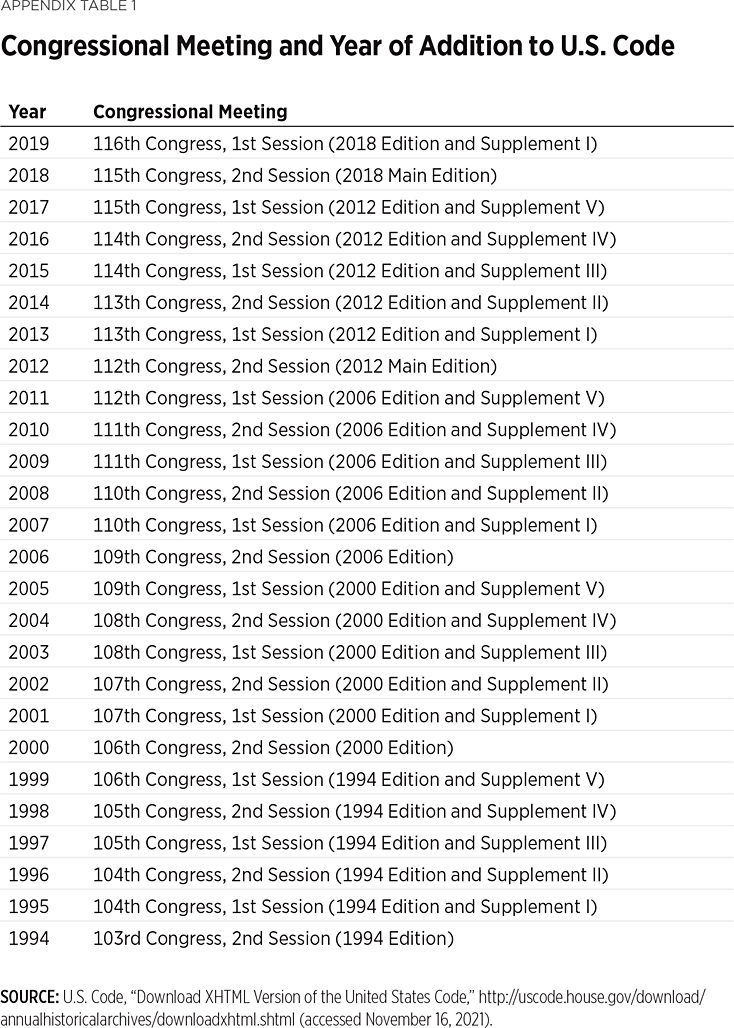The Roman Emperor Caligula, infamous for his caprice and malice, published new tax laws in small font and hung them high atop pillars to entrap the people into unknowingly violating them.REF For more than 2,000 years, this sort of behavior has been condemned as fundamentally unjust because no person can fairly be expected to obey a law that is unknowable.REF A government might hide its laws by putting them out of sight, but it achieves the same result by passing so many laws that no citizen could possibly read them all. James Madison made this point in The Federalist Papers saying, “It will be of little avail to the people that the laws are made by men of their own choice if the laws be so voluminous that they cannot be read.”REF This problem is most dire when the laws at issue are criminal ones because violators may be deprived of liberty and, in some cases, even life.
For this reason, scholars, activists, politicians, and judges have been trying to study, quantify, and rein in the explosive growth in the number of federal crime statutes created since 1970.REF As Supreme Court Justice Neil Gorsuch noted at oral argument in Lange v. California, “We live in a world in which everything has been criminalized.”REF Not only has the number of federal crime statutes risen dramatically in the past 50 years, but there is no single place where any citizen can go to learn them all. The federal criminal laws are scattered pell-mell throughout the United States Code and the Code of Federal Regulations.
Some are so vague that even if they were known, no reasonable person could understand what they mean. Others forbid behavior that no person exercising ordinary good judgment would expect to be a crime. And in some cases, it is a federal crime to violate the laws of other countries.REF Former U.S. Attorney General Edwin Meese III, who, perhaps more than any other public figure, has brought attention to this problem, has written that this profusion of scattered, vague, and unintuitive criminal laws “create[s] traps for the innocent but unwary and threaten[s] to make criminals out of those who are doing their best to be respectable, law abiding citizens.”REF In other words, the United States has accomplished by carelessness what Caligula accomplished by scheme.
The first step toward solving this problem is to gain a clear sense of its magnitude. Accordingly, on several occasions during the past 30 years (discussed in more detail in the following section of this paper), various organizations and scholars both inside and outside the U.S. government have tried to count or estimate the number of crimes contained within the U.S. Code. For various reasons, they either failed outright or produced only rough approximations.
A New Approach
The Mercatus Center and The Heritage Foundation worked together in a novel effort to produce the first reliable estimate of the number of sections within the U.S. Code that contain one or more crimes and a reliable estimate of the total number of crimes contained in the Code. This effort is the first effort to “count the Code” since 2008 and is unique among previous efforts in that it employs an algorithm to sift through the Code using carefully selected keywords to count the number of statutes that create crimes.
It is important to note what this study does not do: The study does not attempt to count the number of crimes contained within federal regulations. The Code of Federal Regulations is much more voluminous than the U.S. Code and is scattered across 236 volumes containing more than 175,000 pages.REF
Previous efforts to count the number of crimes contained in the U.S. Code have faced two significant obstacles: (1) determining which sections create crimes versus civil penalties, and (2) determining the number of crimes created by a single section. Each effort has also suffered, to varying degrees, from a lack of resources with which to parse the Code’s 53 titles and 48,367 sections.REF
Advantages. We determined that using an algorithm to identify each sectionREF that creates a crime would significantly diminish the amount of labor required to sift through the Code. Furthermore, we determined that if we could isolate keywords that captured the language that legislators use when creating crimes, we could largely eliminate the first obstacle. We created such an algorithm and settled on keywords that, with a high degree of confidence, are present in sections that create at least one federal crime. Running that completed algorithm through those editions of the U.S. Code that are published in a searchable digital formatREF revealed the following conclusions:
- The most recent (2018) edition of the official U.S. Code contains 1,510 sections that create at least one crime.
- This is an increase of nearly 36 percent relative to the 1,111 sections that created at least one crime found in the 1994 U.S. Code (the first year for which we have data).
- Congress employs no standard language when creating crimes. To the contrary, legislators have employed myriad ways to express the simple idea that “it is a crime to do X.” We have, however, isolated 12 keyword phrases that, with a high degree of confidence, identify crime-creating sections.
- These findings support the conclusions of other studies that the number of federal crimes has increased over time.
- These findings also confirm that the United States lacks a unified criminal code and further support the concerns raised by numerous scholars that federal crimes are too diffuse, too numerous, and oftentimes too vague for the average citizen to know what the law requires of him or her.
In addition to permitting the conclusions summarized in the previous paragraph, our algorithmic approach creates an opportunity to develop substantial new information about the volume of crimes contained in other bodies of law at various points in time. For example, our algorithm can be reused at little cost to create time-series data for federal regulations (similar to what is described in this study for federal statutes) or to create similar data for statutes or regulations from other jurisdictions, such as states or municipalities. Such an expansion of data on crimes across jurisdictions and over time would permit empirical studies on a variety of important topics, such as whether the number of federal crimes is increasing more quickly than the number of state and municipal crimes or whether the growth of the number of crimes is associated with the likelihood of plea bargains.
Additionally, because this study has isolated those statutory sections within the U.S. Code that create at least one crime, it may facilitate research into the mens rea requirements of the many federal criminal laws. Likewise, it can be used to determine whether specific federal crimes are duplicative of one another or duplicative of state and municipal crimes.
Limitations. Although the algorithm offers a novel and informative approach to examining the growth of federal crimes in the U.S. Code, it has three limitations.
First, it cannot precisely count the number of crimes contained within the Code. It has, however, isolated those 1,510 sections that, with a high level of confidence, create at least one crime, thereby greatly reducing the effort required to arrive at a more precise count. Although the algorithm cannot precisely count discrete crimes within sections, we were able to estimate the number of crimes contained within the 2018 edition of the Code at 5,199.
Second, although our keywords return sections containing at least one crime with a high degree of confidence, the flexibility of the English language and the vagueness common in statutory text mean that it is still possible that our keywords have missed provisions. If there was one especially surprising conclusion from this study, it was that legislators use no standard language when creating criminal laws.
Finally, at present, we cannot use the algorithm to view long-term trends in the U.S. Code because the 1994 edition of the Code is, for the moment, the oldest edition for which the Office of the Law Revision Counsel has published a copy in either XML or HTML formats. As the Office of the Law Revision Counsel continues to publish older editions of the Code in these formats, we will be able to track long-term trends.
Past Efforts to Count the Code
At first blush, one might think that counting the number of federal crimes would be an easy task. Because the federal courts cannot enforce common law crimes,REF all federal crimes must trace their origin to a statute.REF One might reasonably assume, therefore, that a simple review of Title 18, Crimes and Criminal Procedure, of the U.S. Code would yield a discrete number. Unfortunately, as Congress has created crimes, it has made no effort to organize them. Congress has spread crimes throughout the Code, resulting in what scholars have described as “an ‘incomprehensible,’ random and incoherent, ‘duplicative, ambiguous, incomplete, and organizationally nonsensical’ mass of federal legislation that carries criminal penalties.”REF
Because of this, several significant efforts have been made to count the number of crimes dispersed throughout the Code.REF No effort has produced anything more than a rough estimate. As mentioned earlier, there are two reasons for this. First, one has difficulty determining in some cases whether a statute creates a crime or a civil penalty. Second, one must exercise judgment in other cases to determine how many crimes a particular provision creates.REF
The OLP. The first effort to count the Code was conducted by the Office of Legal Policy (OLP) of the Department of Justice in the 1980s.REF The OLP did a manual review of federal crimes, which involved flipping page by page through the entire Code (at that time, 23,000 printed pages).REF It concluded that there were approximately 3,000 federal crimes.REF
Even this page-by-page review, however, could not deliver an exact count because a single section could create a variable number of crimes depending on how it was read. According to Professor John Baker—who discussed the OLP’s methods with the director of that study, Ronald Gainer—when the OLP encountered a statute that criminalized more than one act, it employed the following approach to determine how many distinct crimes the statute created:
[S]tatutes containing more than one act corresponding to a common-law crime (e.g., theft, burglary, fraud, etc.) were determined to have as many crimes as there were common law crimes. On the other hand, OLP counted a statute as having only one crime, even though it contained multiple acts, if those acts did not constitute common law crimes.REF
The ABA. The next effort to count the crimes in the Code, conducted by the American Bar Association (ABA) in 1998, avoided making this judgment call at all, concluding that it lacked the resources necessary to replicate the OLP’s manual count.REF Still, it noted that the OLP’s count of 3,000 crimes was “surely outdated.”REF The ABA settled on a count of “statutory sections” that created crimes by conducting a Westlaw search using the keywords “fine,” “imprison,” and variations thereon.REF Unfortunately, the ABA did not clearly delineate between statutory sections and subsections.REF Regardless, it identified 1,020 sections and subsections that created federal crimes.REF
Baker. Professor Baker next undertook to replicate the ABA’s methodology for 1997 through 2003 so as to add any new sections to the ABA’s total.REF He found 128 new sections that created crimes.REF He then used a modified version of the OLP’s method of calculating the number of crimes created by a single section to conclude that these 128 sections created 600 new crimes.REF Extrapolating from several sources, he reached the “fairly conservative” estimate that the U.S. Code contained more than 4,000 crimes.REF
Baker’s Second Study. In 2008, Professor Baker once again updated the count through 2007 and concluded that the U.S. Code had at least 4,450 federal crimes.REF Since then, there have been no other attempts to count the number of crimes in the Code.
Methodology
In the sections to follow, we discuss the development and operation of the algorithm and the selection of search terms.
Development and Operation of the Algorithm. We developed a text-analysis algorithm that helped produce an inventory of crimes contained in a given body of law and adopted this algorithmic approach primarily because a computer program can be reused at little cost for different bodies of law. This method allowed us to create, for example, time-series data for federal statutes (as we have done) or to create similar data for other jurisdictions, such as states or municipalities.
The target body of legal text for this application of the algorithm was the U.S. Code, which contains the general and permanent laws of the United States. We collected the annual U.S. Code in XHTML format from the Office of the Law Revision Counsel’s website, where yearly editions from 1994 to 2019 were available at the time of collection.REF Appendix A provides a table of each year and the associated edition of the U.S. Code, as well as the congressional meeting that is responsible for each edition of the Code. For example, laws enacted by the 116th Congress, 1st Session, would be included in the supplements to the 2018 edition of the U.S Code.
We then pre-processed the XHTML files into a more machine-friendly format. First, we converted the XHTML files to basic or “plaintext” form (.txt files). We retained structural mark-up elements such as year, chapter, title, and section, so that we could then parse separate years and sections of text. Finally, we separated much of the clerical language that does not substantively constitute the text of law wherein crimes are defined (e.g., references, tables of content, appendices) to help avoid false positives.
Once the text had been collected and pre-processed, we iteratively developed a set of search terms to identify sections of the Code that contained at least one crime. We describe the development of these search terms in the following paragraphs.
Selection of Search Terms. One of the more challenging aspects of our effort was to arrive at a set of search terms that, with a high degree of confidence, returned sections that created crimes. We took as a starting point the search terms used by the ABA: “fine!” and “imprison!”REF Professor Baker noted in his report, however, that the ABA’s terms would tend to lead to an underestimation of the number of crimes, and so he proposed additional search terms of his own, which we considered.REF We decided to begin by testing the efficacy of the following terms: “fine!,” “imprison!,” “punish!,” and “violate!” We were concerned, however, that some of these terms—particularly “fine!” and “violate!”—could potentially capture sections that created civil penalties rather than crimes. Accordingly, we devised a way to test whether these terms would reliably identify sections that created only one or more crimes.
We ran the algorithm through the U.S. Code, gathering all the statutes that included one or more of the search terms. We then isolated those sections that included “fine!,” randomly selected 100 of those statutes, and manually reviewed them to see whether they created at least one crime. Of those 100 randomly sampled sections, only 28 created a crime.
The term “fine!” appeared in a variety of irrelevant ways in the U.S. Code. For example, 2 U.S.C. § 2082 describes the conditions under which the United States Capitol Preservation Commission may accept works of “fine art.” Further, 8 U.S.C. § 1281 imposes a civil fine on the owner or commanding officer of a vessel or aircraft who fails to deliver a complete list of his alien crewmembers to an immigration officer upon arrival in the United States.
We repeated this test with the term “violate!” with even less reliable results. Of those 100 randomly sampled sections that included a variation on that term, only seven created a crime. “Violate” and its variations appear in innumerable ways in the Code. Some sections, such as 42 U.S.C. § 1396b, create civil penalties, while others, such as 15 U.S.C. § 2603, give enforcement power to government officials to restrain violations of other laws. Variations on “violate” also appeared frequently in sections such as 16 U.S.C. § 706, which authorizes officials to arrest people for violating criminal provisions.
We conducted another test of the following three terms together: “fine!,” “imprison!,” and “punish!” In this test, we randomly selected 100 sections that hit on at least one of those search terms: Only about 80 percent of them created a crime.REF Variations on “punish” and “imprison” frequently appeared in the context of criminal procedure, such as in 21 U.S.C. § 851, which governs proceedings to establish prior convictions. Even sections from Title 18 that hit on variations of all three of the search terms did not necessarily create a crime. For example, 18 U.S.C. § 216 sets out the punishment for violating crimes established by other sections, but does not itself create any crimes.
To improve the algorithm’s ability to identify criminal sections, we began to review the language used in those sections to learn if more specific phrases would increase this percentage. At the same time, however, we remained cognizant that increasing the specificity of the search terms might cause the algorithm to miss some sections. Accordingly, as we made the search terms more specific, we also increased the number employed. After our first review of the statutory language, we settled on the following 10 terms:
- “Shall be fined under this title, imprisoned”;
- “Be fined under this title or imprisoned”;
- “Imprisonment for not more than”;
- “Sentenced to imprisonment or death”;
- “Be fined not more than”;
- “Imprisoned not more than”;
- “Be punished by a fine”;
- “Shall be fined or imprisoned”;
- “Shall be fined”; and
- “Shall be punished.”
We conducted two tests with these terms. In the first, as in our previous tests, we manually reviewed 100 randomly selected sections that included at least one of these terms. One error occurred when the algorithm mistakenly identified a search term in the notes appended to the section. Nevertheless, all 99 of the remaining sections created crimes. The second test was designed to determine whether the new search terms were too narrow. In that test, we randomly selected 100 sections that did not include any of our search terms to verify that they did not create any crimes. That was the case; none of the 100 randomly selected sections without a search term created a crime.
While conducting the first test, we continued to review statutory language and identified two more search terms that were reliably present only in sections that created crimes:
- “Imprisoned for not more than”; and
- “Shall be guilty of.”
After adding these two terms to our list, we again conducted two more tests of the results with 100 randomly selected sections that included at least one search term and 100 randomly selected sections that included no search terms. In the first test, 98 of the sections created at least one crime. The remaining two created a civil penalty. We were unconcerned by that over-inclusivity because the language in sections creating civil penalties is sometimes very similar, if not identical, to language creating crimes.REF In the second test, none of the sections that included no search terms created any crimes.
Results
Having settled on those 12 search terms, we ran the algorithm through the official 2018 Code, and it returned 1,510 criminal sections—our final number. Although our method differed from that of the ABA and Professor Baker, our final number is in line with reasonable expectations based on the findings of those reports. As discussed earlier, the ABA reported 1,020 sections creating crimes,REF Professor Baker’s first report found an additional 128,REF and his second found 91 more,REF for a total of 1,239 criminal sections as of 2007. For the sake of comparison with Professor Baker’s assessment, our estimate for 2007 is 1,413.
Further breaking down these numbers shows that, as of 2018, 1,510 sections fairly track the growth predicted by those three prior studies. In the six years between the ABA’s report and Professor Baker’s first report, Congress passed 128 new criminal sections, or approximately 21 criminal sections per year. In the four years between Professor Baker’s two reports, Congress passed 91 criminal sections, or approximately 23 criminal sections per year.
Our study, conducted 11 years after Professor Baker’s second report, found an additional 271 sections that created crimes—representing an approximate growth of 25 criminal sections per year. Of course, this is not a perfect comparison given the differences in our methodologies, but the similarity strengthens our conclusions. Moreover, Professor Baker acknowledged that the ABA report—and therefore his efforts, which were based on it—tended to undercount the number of sections creating crimes.REF Accordingly, the fact that our number is even higher than his analysis would have predicted supports the accuracy of our methodology.
We carried this analysis one step further and estimated the total number of crimes contained in the 2019 Code. To do that, we took random samples of sections that included at least one search term and manually counted the number of crimes created by each by employing Professor Baker’s counting method. To wit:
- Each traditional or common-law crime (e.g., theft, burglary, fraud, etc.) [was] counted separately as one crime. Thus, multiple crimes may be listed in a single [section];
- Multiple forms of non-traditional crimes or elaborations on traditional crimes (e.g., theft by fraud, misrepresentation, forgery) [were] counted as one crime only, if listed together in one section or subsection.
- If the same or similar non-traditional crimes [were] listed in separate sections or subsections, each section or subsection [was] counted as a separate crime.REF
We then calculated the mean number of crimes created by those sections. We calculated a separate mean for sections within Title 18 because we found that those sections tended to create fewer crimes than sections in other titles. The average number of crimes created by sections in Title 18 was about three, and the average number of crimes created by sections in other titles was about four.REF We then multiplied these averages by the number of sections within those titles that included at least one search term, and that approach gave us the final estimate of 5,199 discrete crimes within the 2019 Code.REF This number confirms that Congress has ignored calls from scholars across the political spectrum to reduce the number of crimes in the U.S. Code.REF
Our data are available online.REF
Validation
We employ an ex-post, inductive validation strategy based on examining changes over time and discrete episodes of federal criminalization that experts generally acknowledge. Omar Al-Ubaydli and Patrick McLaughlin discuss the effectiveness of an ex-post validation strategy and apply it to examining a new database, RegData, which was the first industry-specific series for regulation.REF Similar to the strategy employed by Al-Ubaydli and McLaughlin—and in addition to checking our estimate with past efforts as discussed in the second section of this paper—we investigated our data to check whether they are consistent with the stylized facts on longitudinal changes and different episodes of federal criminalization.
In the following paragraphs, we examine two aspects of federal criminalization that are commonly accepted as stylized facts: (a) increased federalization of crime over time, and (b) differences in the post-mid-1990s approach to crime.
Increased Federalization of Crime Over Time. The first stage in our ex-post validation approach was to examine the trend of federal criminalization. Although our Count the Code data is the first panel series to provide a comprehensive, cumulative, and updated number of statutes that create a federal crime in the U.S. Code, a handful of other aggregate estimates already exist. As discussed in the second section of this paper, all three major existing counts (OLP, ABA, and Professor Baker in the Federalist Society report) find an overall increase in the number of federal statutes that create a crime and the estimated number of federal crimes over time. This finding is consistent with the general insights by experts and the public that federal criminalization has been increasing during the past several decades.REF
In summarizing this increased federalization of crime, Professor Julie O’Sullivan wrote: “The ‘federalization’ of criminal law–that is, Congress’ increasing penchant for making federal crimes of offenses that traditionally were matters left to the states—has been well documented” and “the ‘federalization’ and ‘overcriminalization’ trends show no sign of abating.”REF
Similarly, the ABA concluded: “Whatever the exact number of crimes that comprise today’s ‘federal criminal law,’ it is clear that the amount of individual citizen behavior now potentially subject to federal criminal control has increased in astonishing proportions in the last few decades.”REF The federalization of crime has also been well documented in popular press and media—especially in relation to the increased number of federal drug laws and subsequent federal drug offenses and convictions.REF
We checked this stylized fact of increased federalization of crime over time. Our data indicate that from 1994 to 2019, the number of sections that create a federal crime has increased by 36 percent. In 1994, the number of statutes that created a federal crime in the U.S. Code was 1,111, and in 2019 it was 1,510. Chart 1 illustrates the increase in the number of criminal sections over time.
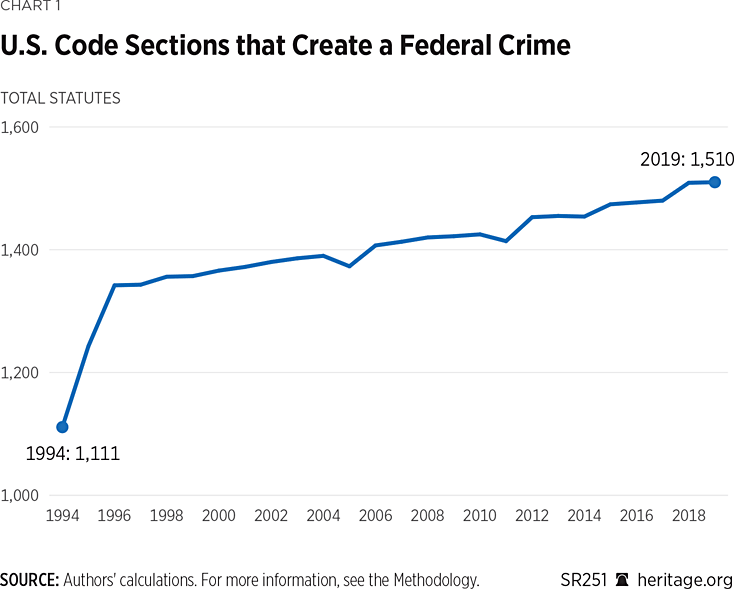
As discussed previously, we also provided an estimated number of federal crimes created per year. In 1994, there were an estimated 3,825 federal crimes, and by 2019, there were an estimated 5,199 federal crimes. Chart 2 shows our estimated number of federal crimes created per year.
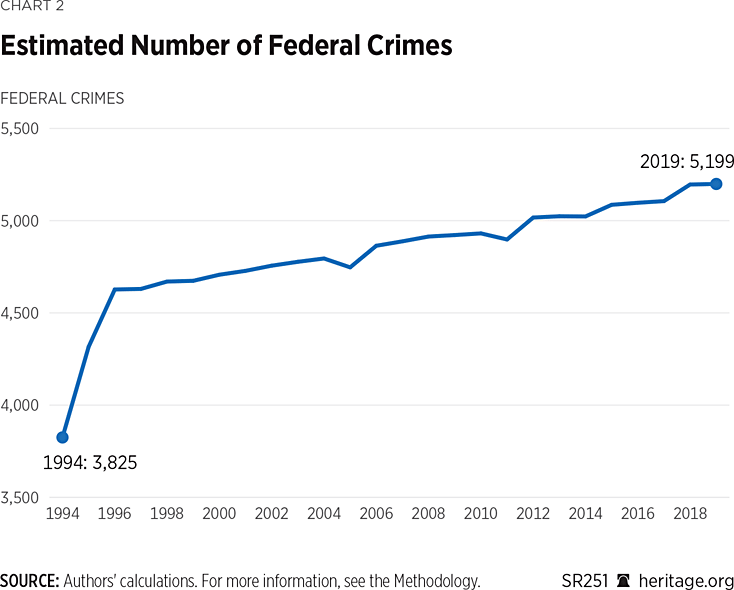
The average annualized growth rate of federal criminal statutes is 1.27 percent. The number of sections that create a crime has increased every year except for three periods: 2004–2005, 2010–2011, and 2013–2014. These three periods when the total number of federal crime statutes fell may be a result of amendments or expirations of sunset clauses related to criminal statutes. For example, in the Fair Sentencing Act of 2010, some parts of the Anti-Drug Abuse Act of 1986 were amended—including eliminating entirely a mandatory minimum imprisonment for first-time possession of crack cocaine.REF
Although we were unable to determine through our data whether this amendment specifically contributed to the decrease in the total number of federal crime sections that year, it could be one possible contributor because of the timing and the magnitude of this reduction. From 2010 to 2011, the number of federal crimes fell by only 0.77 percent, representing approximately 11 sections that create a federal crime.
Overall, our Count the Code data support the stylized fact that federal criminalization has grown in almost all years studied. Thus, our data pass the first and modest test of ex-post validity.
Differences in Approach to Crime Post-1996. Scholars generally acknowledge that the law-and-order theme beginning in the mid-1960s became a driving force that shaped American criminal justice policies for the next few decades. Scholars often called this time period from the mid-1960s a “turning point” for criminal justice and prison policy.REF At the time, crime was spiking across cities in the United States, and then-President Lyndon Johnson called for a “War on Crime.” The approach of being hard on crime proliferated through President Richard Nixon’s era in the early 1970s, and some of the most important federal policies on crime were passed during that time—mainly, the Comprehensive Drug Abuse Prevention and Control Act of 1970, the creation of a special narcotics task force, and the Reorganization Plan No. 2 of 1973 that established the Federal Drug Enforcement Agency.
The law-and-order phase also drastically expanded in the mid-1980s until the mid-1990s. During this time period, new policies were passed that created new federal crimes and provided harsher enforcement and sentences for existing crimes. Important federal legislation included the Aviation Drug-Trafficking Control Act of 1984, the Comprehensive Crime Control Act of 1984, the Anti-Drug Abuse Act of 1986 (and 1988), and the Violent Crime Control and Law Enforcement Act of 1994 (also known as the 1994 Crime Bill).
In discussing the important sentencing policies during the time, Jeremy Travis, Bruce Western, and F. Stevens Redburn explain:
[F]rom the mid-1980s through 1996, [this phase] aimed primarily to make sentences for drug and violent crimes harsher and their imposition more certain. The principal mechanisms to those ends were mandatory minimum sentence[s], three strikes, truth-in-sentencing, and life without possibility of parole laws.REF
Legislation throughout individual states reflected the general theme of “tough on crime” during this period. Moreover, even though federal crime during this time period focused mainly on drug and violent offenses, new federal criminal laws were also enacted related to arson, money laundering, espionage, and other particular crimes, such as the “disruption…of an animal enterprise” (Animal Enterprise Protection Act of 1992) and the creation of car theft as a federal criminal matter by the Anti-Car Theft Act of 1992. Political scientist Naomi Murakawa indicates that this phase from the 1980s through the early 1990s is also associated with Democratic party platforms that used the same law-and-order rhetoric to appease voters who wanted governments to be tough on crime.REF
But as crime rates began to fall broadly in the early 1990s and the following decades, there was a marked shift away from the tough-on-crime phase.REF Travis, Western, and Redburn call this phase from 1996 onward “a period of drift” in which “[t]he impetus to undertake comprehensive overhauls or make punishments substantially harsher has dissipated.”REF
The changes through these phases can also be reflected in prison growth rates across four different decades. Figure 3 shows heightened growth rates of federal and state prison populations and local jails in the 1980s and a high growth rate throughout the 1990s for federal prisons. In particular, the most dramatic change in the federal prison population was for drug-related offenses, which increased more than 10 times from 1980 to 2000, likely reflecting the changes in federal drug legislation as described above. Indeed, scholars attribute the new drug laws of the 1970s and 1980s for leading to historically unprecedented imprisonment for drug use and possession.REF By the end of the 2010s, federal and state prisons and local jail populations had all considerably decreased.
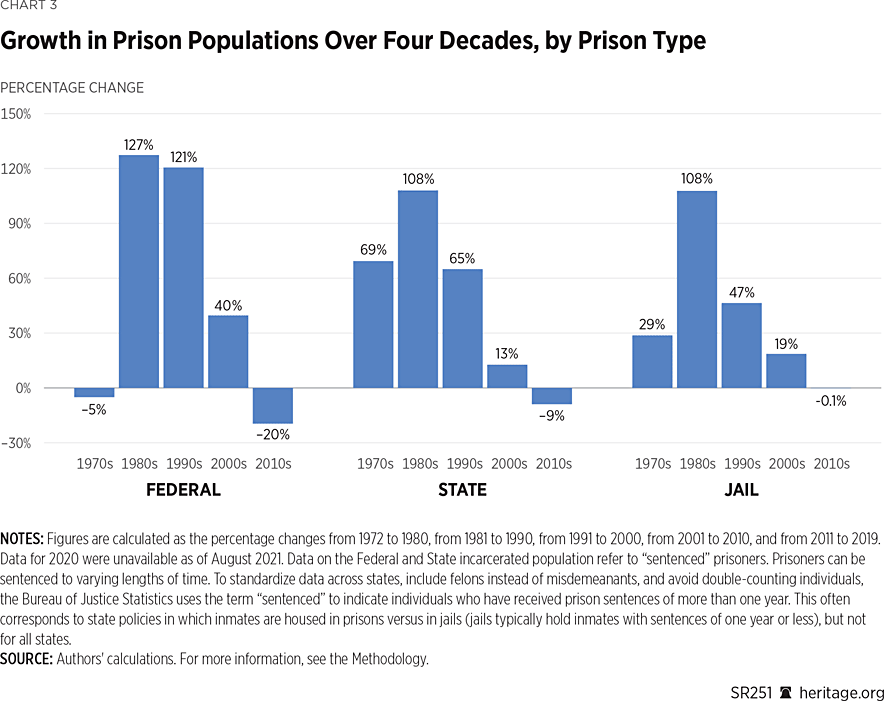
Although our data do not provide a way to examine the creation of new crimes under each relevant statute, we can use a year-by-year growth rate to measure new federal statutes that create a crime in each year. Because the impetus to drive home a tough-on-crime agenda played a significant part in politics up until the mid-1990s, we would expect to see greater growth in statutes that create a federal crime before the mid-1990s, and less growth after the mid-1990s.
Table 1 presents our data of annual growth rates from 1994 to 2019. The time periods with the greatest increase in statutes creating federal crimes were 1994–1995 (12 percent), followed by 1995–1996 (8 percent). If we compare this expansion to any period of federal crime statute growth after 1996, we see, at most, an increase in federal crime statute growth from 2011 to 2012 of almost 3 percent.
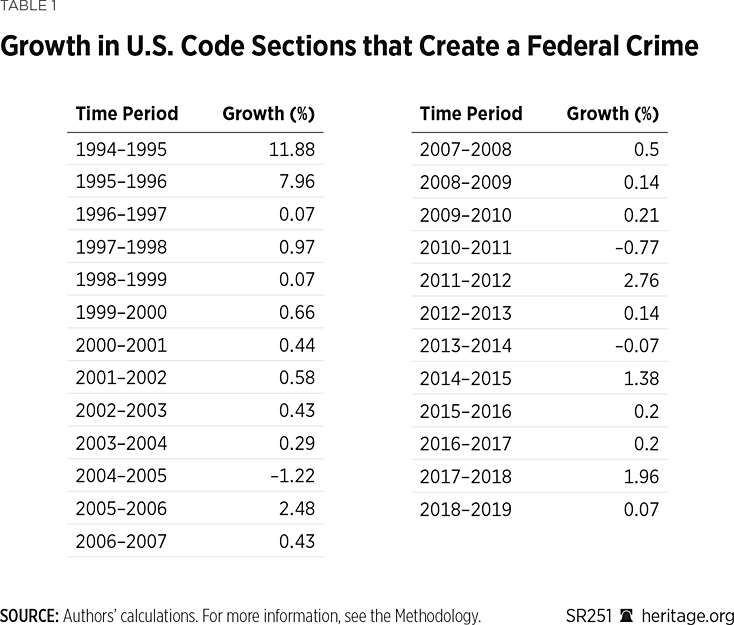
Chart 4 illustrates the annual change in the growth rate of new Code sections that create a federal crime. In fact, the growth in federal crime statutes from only 1994 to 1996 accounts for more than half of the total growth in federal crimes in the entire 22-year time period, as illustrated by Chart 5.
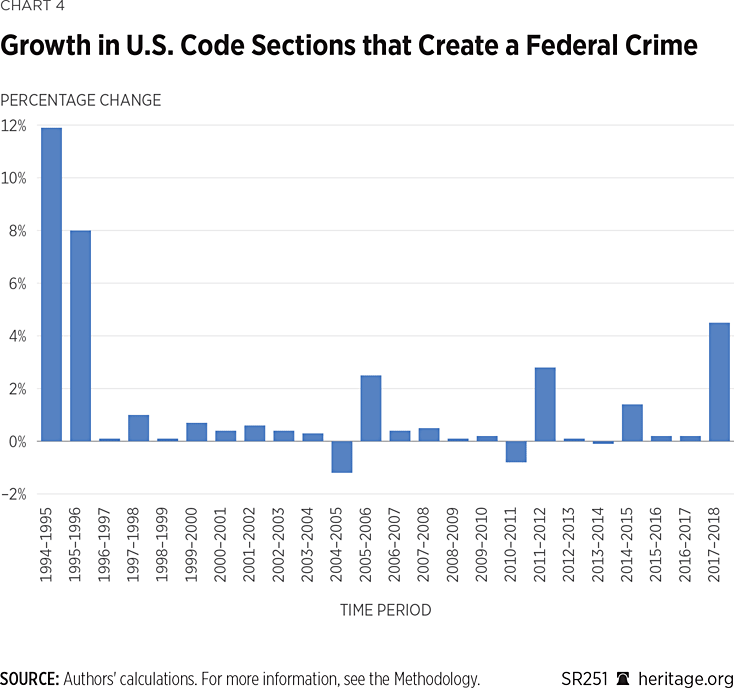
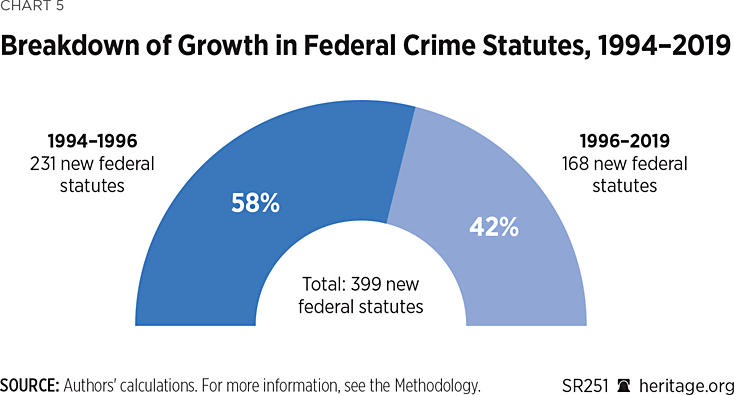
Although an important limitation is that our dataset extends back only to 1994, a notable change in federal growth rate in federal crime statutes occurred before and after 1996, which reflects the general understanding of the approach to crime before and after 1996.
To provide some context, we include the most relevant bills that contributed to the significant changes in high growth of federal criminal statutes during the period of 1994–1996 as follows:REF
- 1995: 104th Congress, 1st Session (1994 Edition and Supplement I)REF
- Sex Crimes Against Children Prevention Act of 1995
- Lobbying Disclosure Act of 1995
- ICC Termination Act of 1995
- Perishable Agricultural Commodities Act Amendments of 1995
- CFTC Reauthorization Act of 1995
- 1996: 104th Congress, 2nd Session (1994 Edition and Supplement II)REF
- Antiterrorism and Effective Death Penalty Act of 1996
- Economic Espionage Act of 1996
- Omnibus Consolidated Appropriations Act, 1997
- Child Pornography Prevention Act of 1996
- Illegal Immigration Reform and Immigrant Responsibility Act of 1996
- Domestic Violence Offender Gun Ban
- Comprehensive Methamphetamine Control Act of 1996
- Drug-Induced Rape Prevention and Punishment Act of 1996
- Church Arson Prevention Act of 1996
- False Statements Accountability Act of 1996
- Health Insurance Portability and Accountability Act of 1996
For the changes from 1994 to 1995, the largest contributor is likely the Sex Crimes Against Children Prevention Act of 1995, which amended several chapters in Title 18, including increased penalties for conduct involving sexual exploitation of children, transportation of children, and the use of computers in sexual exploitation of children. Indeed, we found a big jump in our data in Title 18 from 1994 to 1995, which accounts for about 40 percent of the change in that year.
Other bills enacted through the 104th Congress, 1st Session, that amended Title 18 include the Lobbying Disclosure Act of 1995 and the ICC Termination Act of 1995. Moreover, several changes to Title 7 also contributed to the overall increase in federal crime statutes in that year, and the following bills altered Title 7 in that year: the Perishable Agricultural Commodities Act Amendments of 1995, the CFTC Reauthorization Act of 1995, and the ICC Termination Act of 1995.
Several laws could have contributed to the growth in federal criminal statutes from 1995 to 1996. According to our data, most changes occurred in Title 18 or Title 42 of the U.S. Code. Title 42 had the largest increase of federal statutes (about 72 criminal sections). Bills enacted through the 104th Congress, 2nd Session that had significant changes to Title 42 are the Health Insurance Portability and Accountability Act of 1996, Antiterrorism and Effective Death Penalty Act of 1996, Church Arson Prevention Act, and Economic Espionage Act of 1996. All these bills and the Omnibus Consolidated Appropriations Act of 1997, False Statements Accountability Act of 1996, Comprehensive Methamphetamine Control Act of 1996, and Drug-Induced Rape Prevention and Punishment Act of 1996 added federal criminal statutes to Title 18.
Applying Count-the-Code Data to Research Questions
Our Count the Code data can be useful in combination with other datasets and for specific research questions related to government and crime. In this section, we briefly present some preliminary ideas for further investigation. The goal is not to present a thorough analysis, but rather an example of the way our data can be used, in relation to our datasets, to examine research questions of interest.
Redundant Criminal Laws. A long-standing criticism of the haphazard expansion of federal crimes is that new federal criminal laws duplicate state laws or existing federal laws, resulting in a patchwork of redundant crimes.REF
This duplication has a number of downsides. Among other things, it erodes principles of federalism by having federal authorities police conduct that has traditionally been viewed as better left to state and local governments.REF At the same time, duplication dilutes political accountability because the public is not able to discern who has primary authority for addressing a particular crime or who to blame if a particular crime is not addressed. Duplicative laws also waste limited federal resources on problems better left to the states or already addressed by other departments of the federal government.REF
Additionally, duplication forces federal law enforcement to engage in the sort of on-site policing in which they lack the experience of local police.REF Duplicative laws also expose offenders to multiple prosecutions arising out of the same underlying conduct.REF Finally, duplicative federal crimes give prosecutors wide latitude to charge different people committing the same offenses with different crimes, opening the door for bias to factor into charging decisions.
To understand the scope of this problem and to isolate duplicative federal crimes requires a reliable catalogue of all those Code sections that create crimes, which until now has not existed. Our algorithm provides that catalogue and therefore makes that avenue of research feasible.
Mens Rea Reform. Another long-standing criticism of overcriminalization is that it erodes the law’s traditional requirement that crimes include a mens rea (“guilty mind”) element.REF Before the law would impose criminal punishment, it traditionally required some showing that the defendant acted with some amount of intent, such as premeditation, knowledge of wrongfulness, recklessness as to potential harms, etc.REF The Supreme Court has described this requirement as “universal and persistent in mature systems of law.”REF It is no longer universal or persistent among those federal crimes created during the explosive growth since the 1970s.REF On the contrary, as a bipartisan group of Members of the U.S. House of Representatives observed in 2013, the modern trend in federal crimes has been, at best, toward imprecise mens rea elements and, at worst, toward none at all.REF
Mens rea reform has attracted support on both sides of the political aisle.REF But as with concerns about duplicative criminal laws, research into the scope and effects of inadequate mens rea elements in the federal criminal laws will be improved if built upon a reliable catalogue of all federal criminal laws. With our data, researchers could, for example, study the mens rea elements in every federal criminal statute to determine how many are inadequate. Researchers could also observe the effects that those inadequacies have on prosecutions based on those provisions.
Criminal Law as Deterrence. Other important research questions in crime and public policy relate to whether more criminal laws on the books deter criminal behavior.REF The common perception is that more criminal laws and greater sanctions will deter criminal behavior. To this end, many public officials in the United States have advocated for the criminalization of certain undesirable behaviors and for the use of more severe sanctions as a means of deterring crime.
This empirical question was investigated by economists, who focused not only on official laws but also on the magnitude of the punishments, the probability of being arrested, the probability of receiving punishment, and the speed with which the person receives the punishment. Evidence indicates that individuals who believe they are likely to be arrested and punished are less likely to commit a crime than those who do not expect to be captured or punished.REF
Several research papers also examined the effect of more police officers on streets (through the mechanism that more police officers increase the likelihood of being caught and arrested and therefore may deter crime) and found that increased police presence does reduce crime.REF However, studies that used the 1994 Crime Bill allocation for a grant that provided 100,000 new police officers across U.S. cities as a natural experiment found mixed results about whether more police officers on the streets have contributed to a reduction in crime.REF Other research papers have examined whether imprisonment, in particular, deters crime. The idea is that imprisonment can reduce crime either through a deterrence effect or an incapacitation effect. (Criminals in prison cannot commit more crimes.) Researchers have found mixed results.REF
Our data can be used as a variable that indicates the number of federal crimes on the books. Depending on the research question, the data can be used to examine whether the greater number of crime statutes, greater enforcement, greater severity of punishment, or greater likelihood of being arrested or convicted may be correlated to changes in actual criminal behavior and crime rates. To this end, the number of criminal laws on the books could be either an important control or the variable of interest in examining the question of crime and deterrence.
Because our dataset provides the number of sections that create a crime on the federal level, it could be used with other datasets related to federal crime. In particular, our data would complement the Bureau of Justice Statistics, which provides the following data from its Federal Justice Statistics Program (FJSP) database that could be combined with our data to examine the question of deterring criminal behavior:REF
- Suspects in criminal matters investigated by U.S. attorneys, also by offense;
- Suspects arrested for federal offenses, also by offense;
- Suspects in federal offense matters received, suspects in matters declined, suspects in matters concluded, and the way matters were concluded;
- Sanctions imposed on offenders convicted and sentenced in U.S. District Court, also by offense;
- Case processing times, also by offense;
- Offenders convicted and sentenced in U.S. District Courts, including whether the offenders were sentenced to probation only, to prison and for how long (data including the mean number of months of imprisonment imposed, also by offense);
- Releases of federal prisoners, also by offense; and
- Number of first releases and percentage of sentence served, including mean time served to first release (also by offense), by length of sentence imposed, and by type of case.
These specific datasets from the Bureau of Justice Statistics would provide information for other variables of interest, such as the probability of being arrested and convicted, the severity of actual punishment served, and the time frame from arrest to punishment. Thus, researchers could use our data to ask general questions about whether criminal laws on the books, controlling for other factors, relate to actual criminal behavior and crime rates. In addition, researchers could use our data to ask specific questions about the relationship between federal criminal laws and federal crime deterrence, using also the combination of data from the Bureau of Justice Statistics provided earlier.
Relationship Between Federalization of Crime and Federal Prisoners. The U.S. incarceration rate has received significant scholarly and public attention. Criminology, sociology, political science, and economics researchers have focused on examining the causes and consequences of the drastic increase in the number of incarcerated individuals that have resulted in the United States having the highest incarceration rate of any country in the world.
There are a multitude of discussions about the increased federalization of crime and its connection to the increase in the number of federal prison inmates—which has risen by more than 500 percent since 1980.REF Until recently, the federal prison system has continued to grow even when the state prison rate declined in the past decade.REF Travis, Western, and Redburn discuss how changes in policies and laws beginning in the late 1960s and accelerating in the late 1980s until the mid-1990s may explain the rise in federal incarceration rates.REF
To contribute to this literature, researchers can use Count the Code data to quantify the actual number of U.S. Code sections that create crimes and examine them in relation to federal prisoner data. The Bureau of Justice Statistics provides yearly National Prisoner Statistics—both on federal and the state-by-state levels—available from 1921. Several key variables of interest may be relevant for those interested in understanding the relationship between the federalization of crime and federal prisoners, to wit:
- Number of sentenced federal prisoners by most serious offense and by demographics (race, gender, age);
- Number of federal prison admissions by most serious offense and by demographics (race, gender, age);
- Number of federal releases by most serious offense and by demographics (race, gender, age);
- Total number of federal prisoners in custody (by end of each year) by most serious offense and by demographics (race, gender, age); and
- Federal and state prison capacities.
By way of example, in Chart 6, we illustrate the number of statutes that create a federal crime each year (in blue bars, measured on the left-hand axis) with the aggregate number of sentenced federal prisoners each year (orange line, measured on the right-hand axis).
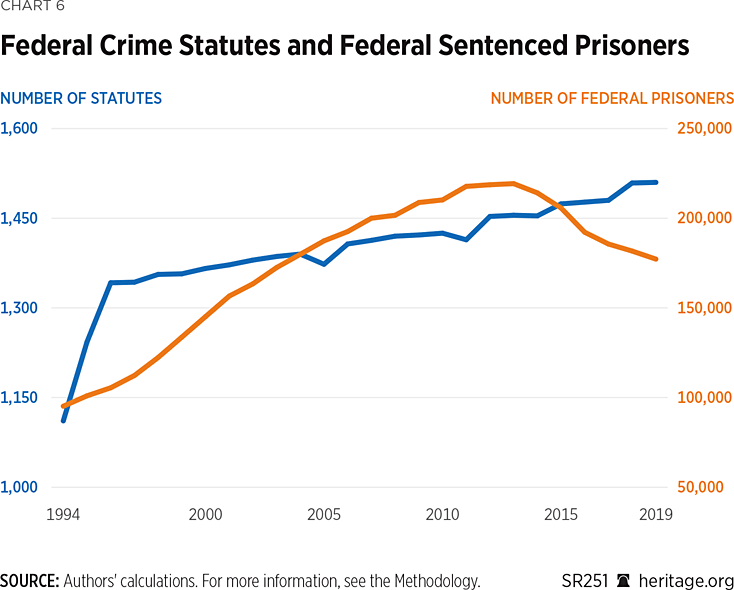
As expected and observed, there is a lag in the increase in the number of sentenced federal prisoners that follows the increased federalization of crime. As the growth in the number of federal criminal sections levels off, there is also a lagged decrease in the number of sentenced federal prisoners. However, changes in the actual number of federal prisoners is notably related to the enforcement of federal crimes—that is, although many drug crimes may continue to be on the books, enforcement of drug crimes has declined during recent years.REF At the same time, although few federal crimes have been added specifically for immigration-related offenses, there has been a momentous growth in population-adjusted immigration enforcement and offenses.
Nonetheless, the changes in the number of federal criminal sections also represent a national attitude and approach toward crime, which had leveled off toward the end of the 1990s. At that time, actual crime rates dropped throughout U.S. cities, and a tough-on-crime approach became less of a national concern.
Although our example of the number of federal criminal sections and number of federal prisoners is one idea to explore, researchers can ask more complex and specific questions that could relate to the demographics of these federal prisoners or, in particular, prisoners of drug crimes, because many of the increases in federal crime statutes during this period were for drug crimes. These questions could be combined with the previously mentioned Bureau of Justice Statistics FJSP database for federal-related offenses.
Relationship Between Federalization of Crime and Federal Justice Budget. Political science and political economy literature are ripe with questions related to government spending and whether specific programs receive the appropriate allocation of funds to implement the desired ends. For example, attention is often directed toward the federal education budget and whether the Department of Education is allocating appropriate funds that would allow states to meet national directives and education policy goals.REF Our data could be used to examine a subset of this topic because it relates to federal justice programs and the proper allocation of funds.
When Congress passes a greater number of federal criminal laws, is there also a growth in justice expenditures allocated to enforce these laws? This sentiment was discussed by Victor S. Johnson, a representative of the National District Attorneys Association on the ABA Task Force on the Federalization of Criminal Law. He stated that Congress misleads the public by its attempts to fight street crime through federal legislation without providing federal funding to enforce all the new laws, and it creates a situation in which efforts by local law enforcement are “undermined by the unrealistic expectations created by Congress’ well-publicized enactments.”REF This question has become of particular interest in recent decades because of both an increase in the growth of federal inmate populations and notable instances of overcrowding and underfunding of federal prisons.REF
Moreover, there is increased attention to whether new federal criminal laws are being enforced by federal police officers or by state and local police officers via intergovernmental transfers. That is, does the federal government increase the number of federal police to enforce laws when it increases the number of federal crimes? This is the topic of a series of research questions on the increased federalization of local police that are enforcing federal laws using federal justice grants.REF
Researchers can use our federal crime statutes data in combination with the Bureau of Justice Statistics data from their Justice Expenditures and Employment Extracts (JEE) series to examine the questions related to federal programs and funding. The JEE series includes the following important data to assess these topics:REF
- Federal direct expenditures on police protection, justice and legal functions, and corrections;
- Federal intergovernmental expenditures on police protection, justice and legal functions, and corrections; and
- Federal justice employment on police protection, judicial and legal functions, and corrections.
By way of example, in Chart 7 we illustrate the number of federal crime statutes every year (blue stacks, measured on the left-hand axis) and the federal government transfers to state and local police protection every year (orange line, measured on the right-hand axis). By observation, there is significant growth in both the number of federal criminal statutes and the amount of intergovernmental transfers to state and local police between 1994 and 1995. The increase in intergovernmental transfers for police is over 130 percent between 1994 and 1995, and likely reflects some of the allocation for federal grants to local police as part of the 1994 Crime Bill—also known as the Community Oriented Policing Services grants.
In general, both the number of federal crime statutes and the amount of federal government transfers for police protection increased from 1994 to 2016, although there seems to be minimal association in year-to-year changes. For example, intergovernmental transfers increased substantially between 2001 and 2004, and the number of federal crime statutes added in those years changed slightly. This notable increase in federal government transfers to police protection likely reflects the heightened anti-terrorism measures after the September 11, 2001, attacks.REF
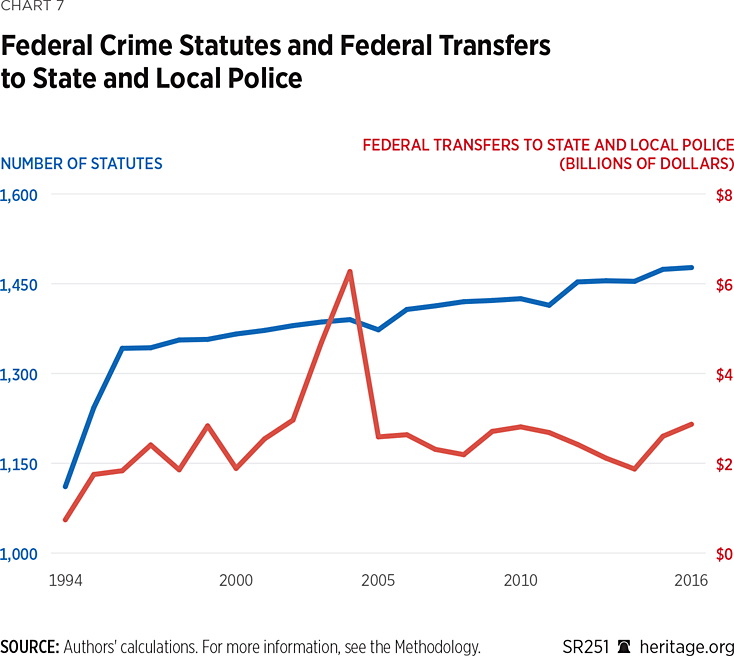
Similarly, our data can be used in combination with the JEE data to examine specifically the relationship between the number of federal criminal laws and federal prison expenditures. Overall, in combination with our data, researchers can examine whether increased federal crimes are associated with increased federal justice expenditures, including which type of justice expenditures increase in relation to federal crime (police, judicial, or corrections), and whether increased federal crimes lead to increased intergovernmental expenditures for states and localities in those three areas—police, judicial, and corrections.
Does Political Party Matter for Increased Federalization of Crime?
The Republican Party is often associated with driving the tough-on-crime or law-and-order political slogan. The law-and-order platform was emphasized by Republican Presidential candidate Barry Goldwater in the 1964 election, and it was also emphasized by Richard Nixon in both the 1968 and the 1972 presidential elections. Under Presidents Nixon and Ronald Reagan, both Republicans, there was an unprecedented expansion of the federalization of crime with important acts such as the Comprehensive Drug Abuse Prevention and Control Act of 1970 (Nixon), Aviation Drug-Trafficking Control Act of 1984 (Reagan), Comprehensive Crime Control Act of 1985 (Reagan), and the Anti-Drug Abuse Act of 1986 and 1988 (Reagan). Some statistical studies also indicate that Republican Party control, especially at the state level, generally has been associated with larger expansions of the prison population.REF
However, the largest crime bill in U.S. history, the 1994 Crime Bill, was passed into law under Bill Clinton, a Democratic Party President. Moreover, some leading Democrats—including Governor Mario Cuomo of New York in the 1980s and early 1990s and Governor Ann Richards of Texas in the early 1990s—presided over large increases in prison populations and/or the approval of tough sentences.
Research by political scientist Naomi Murakawa also shows that the Democratic Party platforms of the 1980s and early 1990s invoked law-and-order rhetoric that “differed little from what Richard Nixon had expressed two decades earlier, and extolled the long list of harsh penal policies the party had been instrumental in enacting.”REF In fact, Democratic politicians in the 1980s also joined the war-on-drug efforts to appeal to voters, and this led to a race-to-the-bottom competition that increased overall criminal laws and penalties for drug offenses. As this rachet-up effect in criminal justice continued, “official party positions on crime control differed less and less.”REF
Our data can be used to contribute to this question of whether there is a difference by political party for being tough on crime by examining congressional majority and presidential party in relation to increases or decreases in the number of federal crime statutes passed. For example, Table 2 provides the number of crime statutes in relation to congressional and presidential party.
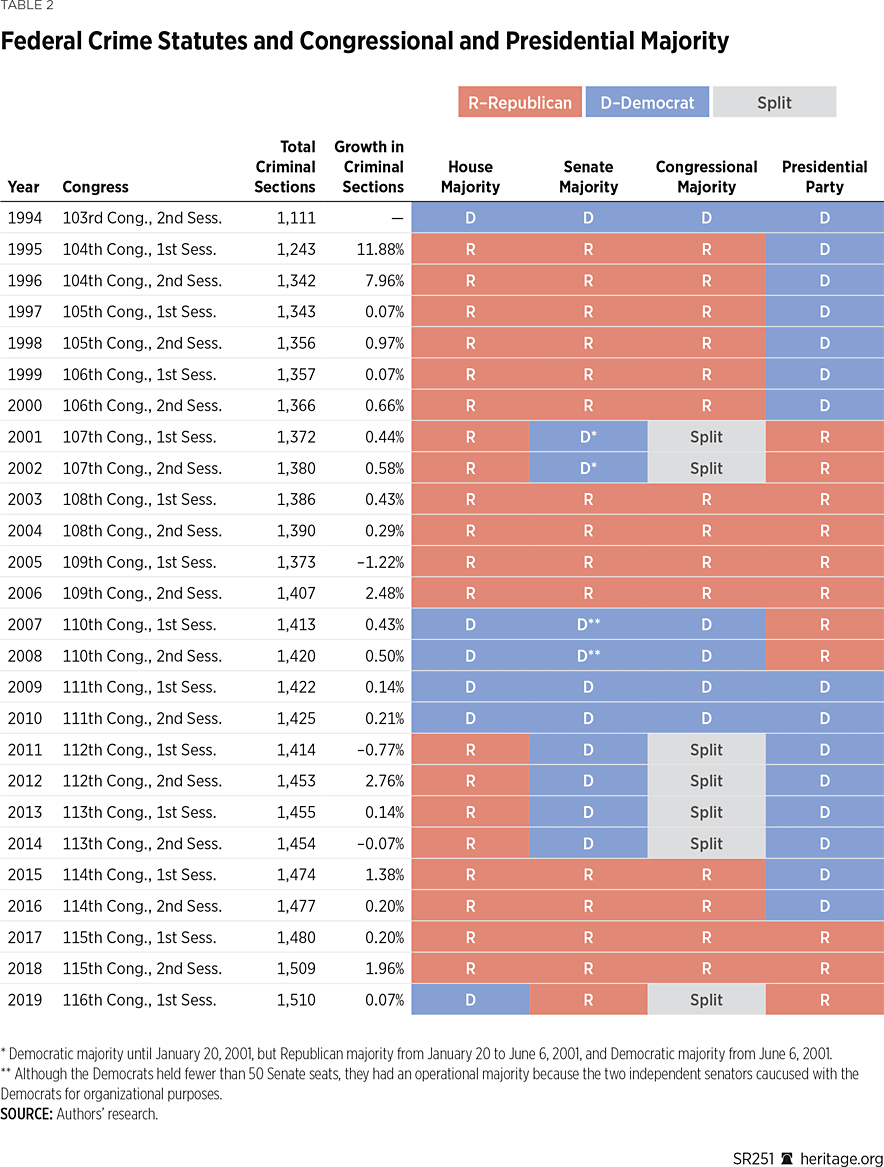
Using Table 2, a basic statistical analysis reveals that there does not seem to be a significant difference in Republican- or Democratic-controlled Congress or Republican or Democratic Presidents that matters for changes in federal criminal sections, similar to findings by Naomi Murakawa and other scholars.REF However, our strategy was simply to illustrate the potential for further research avenues. Other scholars may be interested in providing a more complex model to examine this question, perhaps in relation to Senate or House majorities as well.
Conclusion
This paper introduces a new dataset, Count the Code, which quantifies the number of federal statutes that create a crime and estimates the number of federal crimes within the U.S. Code. To the authors’ knowledge, no other panel measures of this degree and comprehensiveness exist. We have employed an ex-post validation strategy that demonstrates the consistency of the dataset with stylized facts about federal crime, such as longitudinal changes and notable episodes of increased federalization of crime. Our methodology also renders similar results to other methodologies that have also attempted to estimate the number of federal crimes and the number of statutes that create a federal crime.
To demonstrate the dataset’s value, we have provided six recommendations for how to use our data for further important research questions and explorations:
- Identifies redundancy in federal laws and between federal laws and state laws.
- Furthers mens rea reform efforts.
- Can be a measure of the number of federal crimes on the books for questions relating to criminal law and deterrence.
- Provides the ability to quantify the relationship between federalization of crime and federal prisoners and offenders. The increased federalization of crime has often been discussed in connection with the increased number of federal prisoners.
- Can answer a host of questions associated with federal funding for justice programs in relation to increased federalization of crime and an important question of intergovernmental transfers for implementing and enforcing federal criminal laws.
- Provides a first attempt to formally quantify whether a political party on the national level matters for greater federalization of crime. That is to say, which political party is tough on crime?
Although current Count the Code estimates the number of federal statutes that create a crime, our plan is to provide the number of statutes that create a crime on a state-by-state basis because most criminal matters tend to be state-level matters. This approach will allow researchers to analyze important questions on the relationship between state and federal criminal laws.
It will also provide the ability to exploit variations across state-level criminal law in relation to actual crime rates by state and questions about labor-market implications from increased state criminal laws. The state-level variation can be used for other questions in political science and public choice on whether more criminal laws are passed during election years, by particular political parties, or with regard to notable instances of public attention that demand more popular tough-on-crime stances.
In addition, we plan to increase the number of years in our dataset. This approach will be helpful for gaining a more complete picture of the changes in the number of federal crime statutes because much of the growth in federalization of crime occurred from the 1970s through the early 1990s. As such, this expanded data would increase the number of observations per year and allow researchers to more fully capture longitudinal questions of interest.
Our data are now freely available. As we refine it, we will continue to release updated versions to the public with the goal of facilitating more research on crime.
GianCarlo Canaparo is Legal Fellow in the Edwin Meese III Center for Legal and Judicial Studies, of the Institute for Constitutional Government, at The Heritage Foundation. Patrick McLaughlin, PhD, is a Senior Research Fellow and Director of Policy Analytics at the Mercatus Center at George Mason University. Jonathan Nelson is a Software Developer at the Mercatus Center at George Mason University. Liya Palagashvili, PhD, is a Senior Research Fellow at the Mercatus Center at George Mason University.
